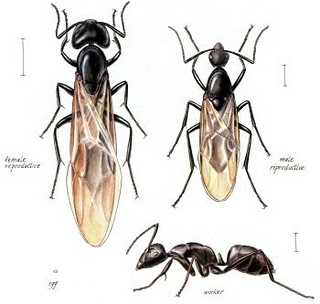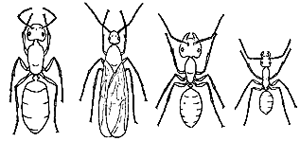Got Carpenter Ants?
Damage From Carpenter Ants
I must admit, I have made a lot of money from carpenter ants and have even been accused of harboring a carpenter ant farm at home, just kidding!
As Carpenter ant colonies grow they expand outward, producing what are called satellite colonies. Satellite colonies eventually mature into hundreds of ant members that will eventually set out to seek to create more satellite colonies.
Established carpenter ants colonies are always responsible for house damage. Usually they have made their nest in wood that was already rotted and probably needed to be replaced anyway, but sometimes they will nest in adjacent dry and healthy wood. That part stinks!
Carpenter Ants Don’t Eat Wood
Contrary to popular belief they DO NOT eat the wood, they remove it to create galleries and tunnels – to live in it.
Carpenter Ants are divided into different castes, i.e. queen, winged male, major worker, minor worker. [See below from left to right.]
What do they look like:
Carpenter ants are large and dark in color. They sometimes have wings – when swarming from their nest. The insects are larger than termites and they have two pairs of wings and bent antennas.
What Do Carpenter Ants Eat:
Carpenter ants feed on sources of protein and sugar. Outdoors, carpenter ants feed on living and dead insects.
Indoors, carpenter ants feed on meats, as well as syrup, honey, sugar, jelly, and other sweets.
Most foraging is done at night between sunset and midnight during spring and summer months. Workers ants can travel up to 100 yards away from a nest in search of food.
Where Do They Live
Carpenter ants nest in moist wood including rotting trees, tree roots, tree stumps, and logs or boards lying on or buried in the ground.
They can also nest in moist or decayed wood inside buildings and are often found around sinks, bathtubs, poorly flashed doors and windows or roof leaks.
Nests have been found behind bathroom tiles; around tubs, sinks, showers, and dishwashers; under roofing, in attic beams, and under sub floor insulation; and in hollow spaces such as doors, curtain rods, and wall voids. Carpenter ants may also nest in foam insulation.
Here are a TEN steps you can take to get rid of and avoid carpenter ants:
1. remove dead stumps from your yard
2. keep wood piles away from your home
3. clear brush, tree branches, and other foliage that are making contact with your home
4. keep your lawn trimmed
5. ensure that your home’s wood siding and trim does not contact the dirt
6. tend to all leaks and ensure your homes flashing’s are intact and working.
7. caulk, or foam seal the gap between the house foundation and the house sill.
8. use a Boric Acid and sugar mixture at and around the house foundation sill. Learn More
9. install gutters to keep the house and foundation dry
10.ensure that the house grade is properly graded to drain water away from the house
~ concord carpenter
source: http://www.extension.umn.edu










